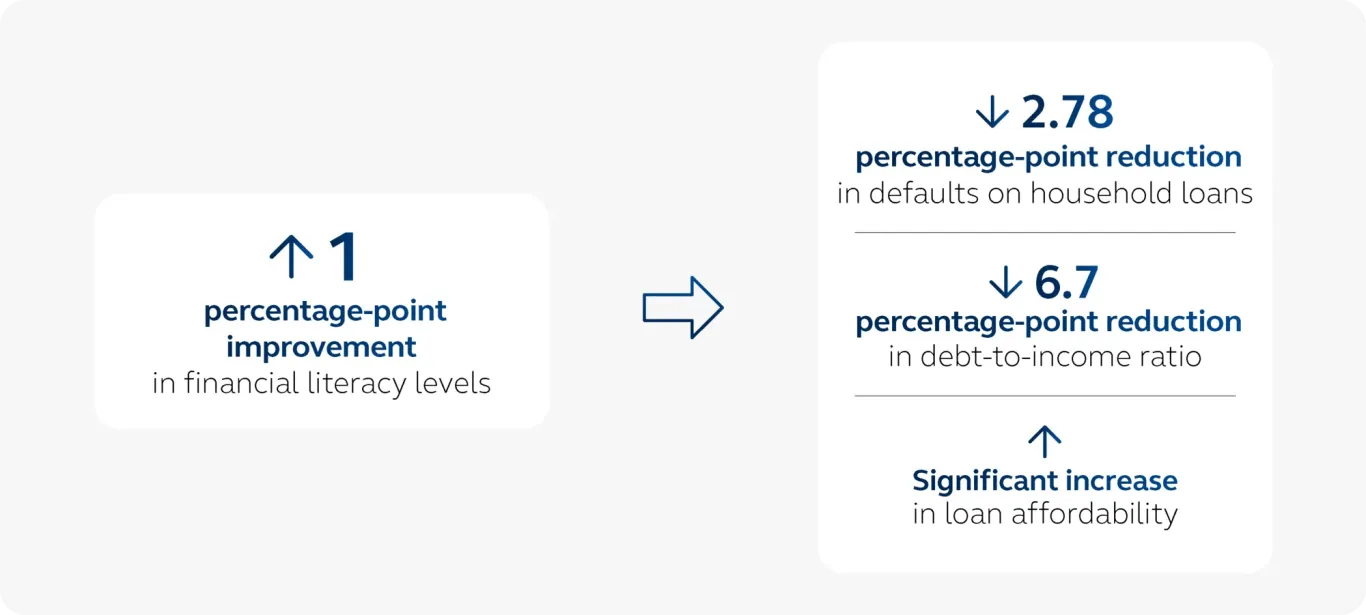Even modest gains in financial literacy can help economies make sustained progress.

New research from the 2025 Global Financial Inclusion Index reveals a clear correlation between improved financial literacy and better household debt management, ultimately contributing to stronger economic growth. The analysis demonstrates even modest gains in financial understanding can lead to significant improvements in loan affordability and GDP growth.
The research, conducted by the Centre for Economics and Business Research (Cebr), found that a 1-percentage-point improvement in financial literacy levels is associated with a 2.78-percentage-point reduction in defaults on household loans
“Better financial literacy is a driver of economic resilience by creating stronger household balance sheets with more sustainable and more affordable debt,” says Seema Shah, chief global strategist at Principal Asset Management®. “When household debt is reduced and people have an improved ability to pay, savings can become more productive and directed toward more growth-focused goals.”
The economic benefits extend beyond individual households. The research indicates that a 10-percentage-point improvement in financial literacy levels could generate a 0.3-percentage-point improvement in GDP growth over a four-year period, above the expected baseline growth rate

A 1% improvement in financial literacy: Associated with a 2.78% reduction in defaults on household loans. Results in significantly increased loan affordability and is associated with a 6.7% reduction in debt-to-income ratios.

A 10 percentage point improvement in financial literacy: Associated with a two-thirds fall in debt-to-income ratio. Could generate a 0.3 percentage point improvement in the rate of GDP growth—over and above the expected growth rate—after a four-year period.
For example, if France were to raise its financial literacy level to 50%, its projected cumulative growth from 2026 to 2029 could increase from 3.7% to 4.4%. Similarly, the United States could see its cumulative growth rise from 6.4% to 6.9% over the same period
Kamal Bhatia, CEO at Principal Asset Management, says wealthier economies typically demonstrate better financial literacy levels. However, the methods of improving financial understanding vary significantly across markets. “Many of the markets making the fastest improvements in financial literacy are also those that rank highly for fintech sector development and digital banking adoption, with some of the best examples being in Asia,” he says.
As technology enables simpler access to financial information and resources, financial education is being embedded into citizens' lived experiences.
This contrasts with many Western markets, including the U.S., U.K., France, and Italy, where financial literacy levels are lower than might be expected given their economic strength. This may be due to their more traditional, theoretical approach to financial education rather than the practical experience gained through an increasingly digitized financial system.
The workplace represents another crucial avenue for improving financial literacy. Teresa Hassara, senior vice president of Workplace Savings and Retirement Solutions at Principal, emphasizes a more financially literate workforce isn't just better prepared—it's more effective and engaged.
“When employees understand how to manage debt, save for retirement, and make confident financial decisions, businesses experience lower stress-related disruptions and greater productivity,” she says.
The research demonstrates a financial literacy flywheel effect:
- Better financial literacy leads to stronger household balance sheets with more sustainable debt.
- Reduced debt and improved payment ability allows savings to be directed toward growth-focused goals.
- Investment in inflation-beating savings products or the stock market boosts the economy and helps capitalize businesses.
These investments are critical for retirement adequacy, helping alleviate the economic drag effect of an aging society.
The net result is an economy more resilient to unexpected shocks and better positioned for stronger growth—making it a more attractive destination for international investors. As markets globally face economic uncertainty and rising household debt, improving financial literacy isn't just helpful—it's becoming increasingly urgent.
The data shows even modest gains in financial understanding can lead to fewer defaults, better access to credit, and stronger economic growth. As governments and financial systems look for ways to build resilience and empower their populations, investing in financial education stands out as one of the most impactful and cost-effective strategies available.
Explore more Global Financial Inclusion Index insights.


